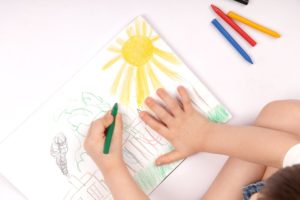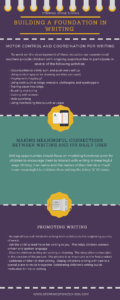Building a Foundation in Writing
Wrapping his tiny toddler fingers tightly around a large crayon, two-year-old Bentley stands over a piece of paper making firm strokes across his page and states then with excitement, “I write!”
Considering her picture from different angles, Mila adds a few letter-shapes – a couple pointy marks reminiscent of M’s and repeating lines like L’s.
After adding eyes and whiskers to his drawing, Jamie thinks intently. Very carefully he adds a wobbly “c” and then excitedly shows his teacher, “I wrote, Cat!”
Early writing skills develop following the same sequence of stages. Children begin to make connections between the marks they make on a paper and a message they wish to convey. As children grow, they develop the motor control and literacy skills necessary for early writing to emerge.
At Stepping Stone School, we are laying the foundation for future success in literacy as we provide children with early opportunities to develop their writing skills.
Motor Control and Coordination for Writing
The ability to write depends on the physical development of several muscles in a child’s hands and forearms along with eye-hand coordination. To work on the development of these muscles our experienced teachers provide children with ongoing opportunities to participate in several of the following activities:
- Opportunities to climb, turn, and push one’s self up
- Using vertical spaces for drawing activities (an easel)
- Playing with Playdough
- Using tools such as tongs, tweezers, clothespins, and eyedroppers
- Tearing paper into strips
- Beading and lacing
- Cutting with scissors
- Hole punching
- Using interlocking blocks such as Legos
Making Meaningful Connections Between Writing and its Daily Uses
Writing opportunities should focus on modeling functional print for children to encourage them to interact with writing in meaningful ways. Writing their name and the names of their friends is much more meaningful to children than writing the letter “A” 10 times.
Providing a meaningful context for writing provides a purpose and adds value. In our prekindergarten classrooms, a pad of paper is made available in the dramatic play center for a child to take another child’s order. At home, parents can provide children with a piece of paper to make their own grocery list before going to the store. Ask your child to read what he or she writes on the list.
Promoting Writing
- Accept all levels of children’s writing from scribbles to the beginning sounds of words
- Ask the child to read his or her writing to you. This helps children connect written and spoken language.
- Observe children as they are writing or drawing. The story often comes alive in the creation of the picture. The process is as important as the final product.
- Celebrate children in their writing. Display children’s writing with care in a special place to revisit it together. Celebrating children’s writing builds motivation for future writing.

References:
Center for Early Literacy Learning. “Art of Writing” and “Get Write on It!” retrieved from http://www.earlyliteracylearning.org/cellpract_parent/toddler/collections/CELL_Todd_Scrib_Draw.pdf
Early Literacy Pre-Writing Skills. Retrieved from http://familychildcareacademy.com/early-literacy-pre-writing-skills/
Geiger, A. (2014). Teaching Tips for Children in Different Stages of Writing Development. Retrieved from http://www.themeasuredmom.com/stages-of-writing-development-help-kids-move/
“Writing Growth Stages” and “The Developmental Stages of Writing” Retrieved from http://www.learningtowrite.ecsd.net/stages%20of%20writing.htm